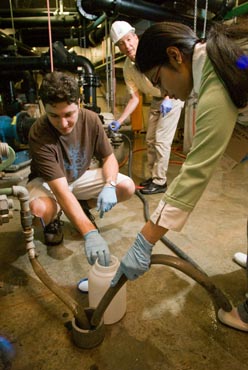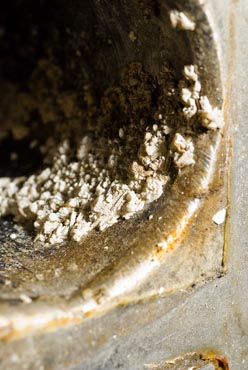Soil scientist’s fascination with mineral yields plan for battling it
Under the microscope, its crystals gleam like tiny gems. But when the phosphate mineral struvite starts clinging to the insides of sewage treatment plants, it tends to lose its charm. Fed by the copious phosphorus in wastewater, struvite crystals form in the billions and amass in huge, cement-like chunks, clogging pipes and valves and blocking water flow.
But it took a student — Menachem Tabanpour — to jumpstart the project and see the industrial possibilities.
“It’s (like) hardening of the arteries, that’s for sure,” laughs Steve Reusser, operations engineer for Madison’s sewage treatment plant. Like wastewater engineers across the county, he’s been chipping struvite out of equipment for decades. “It’s one (problem) that just won’t go away. We keep juggling things, but we haven’t come up with a great solution yet.”
UW-Madison soil scientist Phil Barak thinks he may now have one — and it’s surprising for its counterintuitive logic: Why not grow the pesky mineral on purpose?
“Imagine their response when we told them we wanted to make more struvite,” says Barak. “They were pretty skeptical at first.”

Students Menachem Tabanpour (left) and Merin Abraham (right) are assisted by operations engineer Steve Reusser (center) as they collect a sample of sludge from the Madison sewage treatment plant. The students are working with soil science professor Phillip Barak to develop a solution to combat the build-up of a phosphate mineral called struvite in the pipes of sewage treatment plant equipment.
Photo: Bryce Richter
The point, though, is to control the formation, he says. One of his graduate students, Merin Abraham, has recently done this by dosing a sewage mix called acid digestate with limestone. The rise in pH causes the sewage to shed more than two-thirds of its phosphorus as crystals of struvite and brushite, a related mineral. And because those minerals are denser than water, they settle out of solution on their own, making them easy to remove.
Applied in the sewage treatment process, the technique could allow engineers to strip out struvite crystals before they congeal inside pipes and pumps, says Barak. Limestone is also much cheaper than the iron salts the Madison plant adds now to bind phosphorus and keep struvite at bay.
At the same time, treatment plants would be reducing phosphorus levels in their leftover bio-solids, which are often used as fertilizers. Bio-solids provide a good source of nitrogen, but they have much more phosphorus than crops need, Barak explains, putting the nutrient in danger of running off farmlands and into lakes and rivers.
As for those phosphate minerals filtered out of the waste stream, Barak imagines they could find value as an alternative, slow-release source of phosphorus, allowing farmers to apply only what they need. Recycling the nutrient makes particular sense right now, he adds, when supplies of mined phosphate are dwindling and the cost of phosphorus fertilizer is rising. The researchers hope to test all of those ideas when a pilot project launches at the Madison treatment plant in the next year or two.

Struvite, a phosphate mineral, clings to the interior walls of a heat exchanger at the Madison sewage treatment plant.
Photo: Bryce Richter
For Barak, the project adds an unexpected new chapter to what has been a long fascination with the mineral. It all started more than 25 years ago, when he first encountered struvite as a medical problem. Working as an Army medic at the time, Barak found himself peering through a microscope one day at a urine sample from a sergeant with a bladder infection. What he saw was a collection of razor-sharp struvite crystals that were bringing a “very tough guy” nearly to tears, he says.
After carving that first impression, struvite remained in the back of Barak’s mind until he read about a method for crystallizing minerals on a specialized slick of fatty acid molecules, called a Langmuir monolayer. Other scientists had used this “molecular template” to grow a rare mineral, known as vaterite, from a chemical solution that would normally produce only common limestone. The findings made Barak curious if he could do the same with struvite, and he tucked the idea away as a cool thing to try one day.
But it took a student — Menachem Tabanpour — to jumpstart the project and see the industrial possibilities. Now a senior majoring in biology and French, Tabanpour landed in Barak’s lab in the summer of 2004 as part of a NASA program for gifted high school students. After he grew bored with his first lab assignment, Barak charged him with growing struvite on the monolayer, which he did in no time at all.
For Barak, that would have been enough, but soon Tabanpour had something more to report. While waiting for experiments to finish, he’d been searching the scientific literature and uncovering journal articles about the problems with struvite in sewage treatment plants.
Though the teenager’s discovery was humbling at first, Barak has been glad for it ever since. After all, it turned a mere novelty into a patented invention and a potentially cost-saving remedy for a major wastewater headache.
“I’m not so stodgy to have forgotten that you need to listen,” he says. “The professor doesn’t know everything out of the gate.”
Subscribe to Wisconsin Ideas
Want more stories of the Wisconsin Idea in action? Sign-up for our monthly e-newsletter highlighting how Badgers are taking their education and research beyond the boundaries of the classroom to improve lives.




